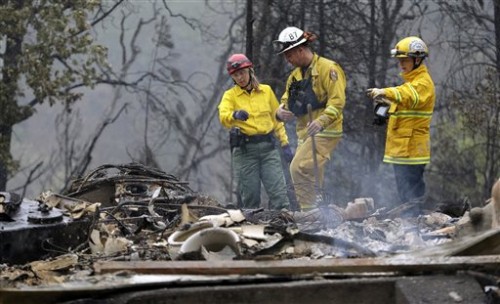
Environmentalists have tracked the uncontrollable drying of California since its noticeable start in 2013. It was to be expected, some said. Droughts and even wildfires are a reoccurring instance of nature.
What was not expected was the longevity of the drought or the other areas it would affect. This week, the state urged residents living closest to one of the three major wildfires to evacuate or risk dying in the flames.
As of Sept. 15, according to the U.S. drought monitor by the University of Nebraska-Lincoln, the entire state of California was reported to be feeling the effects of the drought, though the extent and reach of this drought was much worse. Along with symptoms of the drought, the West Coast has seen a rise in the number of wildfires; there are currently three major wildfires in the state, but they have destroyed more than 285,000 acres and killed at least six people.
“It dried up most of the natural creeks and rivers near the mountains, so we got even more coyotes, deer, and other wildlife walking around at night,” Allegra Socki, resident of Pasadena, said. “(It) is normal in the summers, but there was definitely a noticeable increase.”
Jerry Brown, governor of the state, ordered California’s first water restrictions in April to try to conserve the state’s evaporating resources, but the effects for residents have already been felt.
Food production in the region is being hit hard. Fruit and vegetable prices are rising, which may be connected to the drought in the region. Ocean temperatures have risen and people living near the Pacific have noticed fish, whales and other marine animals around the coast that they’ve never seen before.
“We always react too late to things,” Thomas Murphy, an environmental science professor said of the response to the drought. “The simple explanation is that you don’t know what the issue is going to bring. California regularly has droughts but they come and they go and they’re much less severe.”
One possible cause of the drought is the warming of the planet. The connection to warming is one that Murphy said people don’t understand about the current environmental situation. He believes these droughts are a natural occurrence made more severe by global warming and environmental degradation; ice caps are melting and rain fall in areas that need it most, like California, are nowhere near the levels needed to extinguish the effects of the drought.
The nation is unable to predict what’s going to happen, Murphy said, and leaders don’t concretely know the causes, as well as how severe this drought is going to be this time. All residents and those watching the situation can do is hope for the best, Alan Berman, president of the Disaster Recovery Institute, said.
“California did what they could to conserve water, but it’s a highly agricultural state,” Berman said. “There are lots of ongoing efforts to help, there’s been support from the government and we’re starting to use ‘careful agriculture,’ or selectively setting farm land aside. It’s unfortunate that we don’t know when it will end, but we can hope that it’s short.”
Though California is facing one of the worst droughts in the nation’s history, other states along the West Coast, including Oregon, Washington, Nevada and Arizona are experiencing more instances of extreme or exceptional drought. States along the Northeast are experiencing drought conditions, too. The southern region of Illinois is experiencing the same abnormal dryness.
Murphy suggests that the nation “mitigates” climate change by cutting the nation’s CO2 emissions and limiting the creation of green house gases, similar to the deal between the U.S. and China.
“We always do these (policy changes) when the situation gets out of hand and we suffer the consequences later,” Murphy said. “The chairs of the committees that address this are climate change deniers. We have to cut carbon by 80 percent, fuel consumption by 80 percent, air travel by 80 percent or better to mitigate this crisis.”

